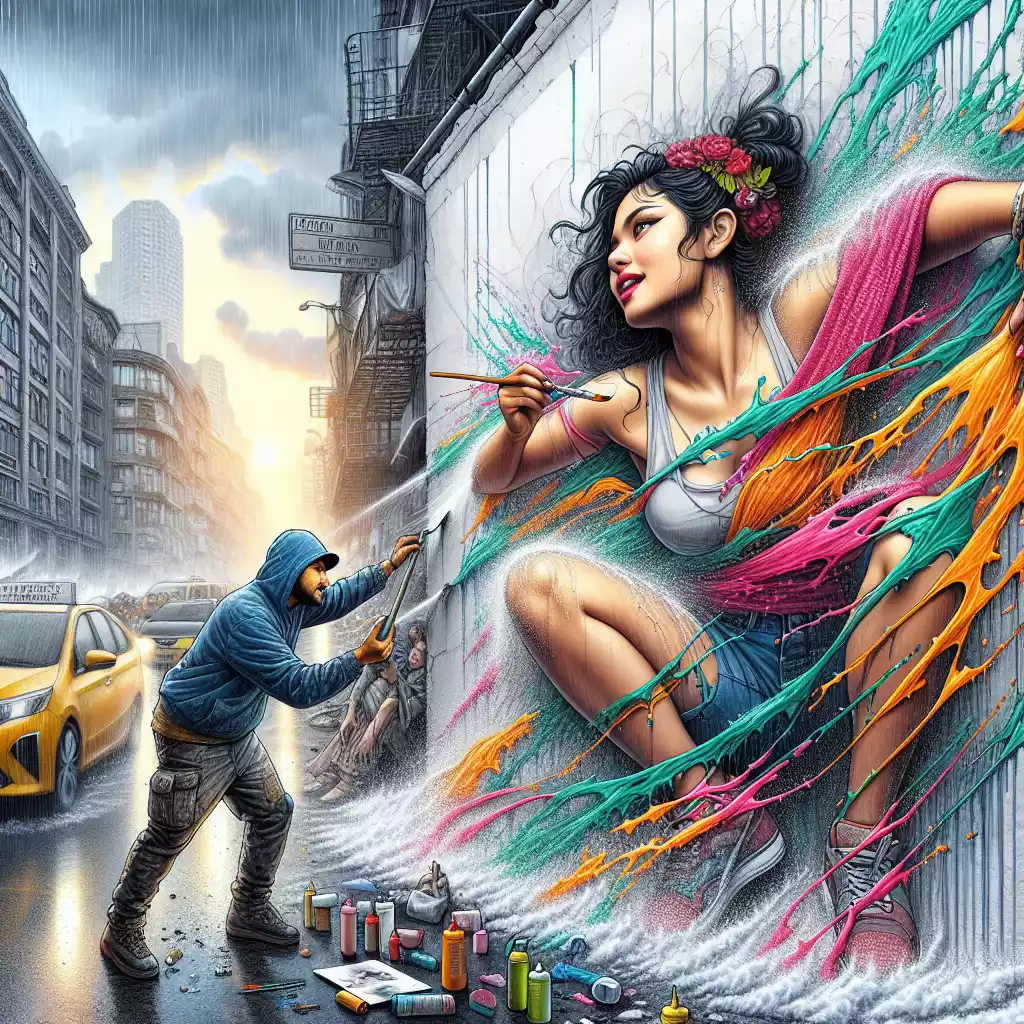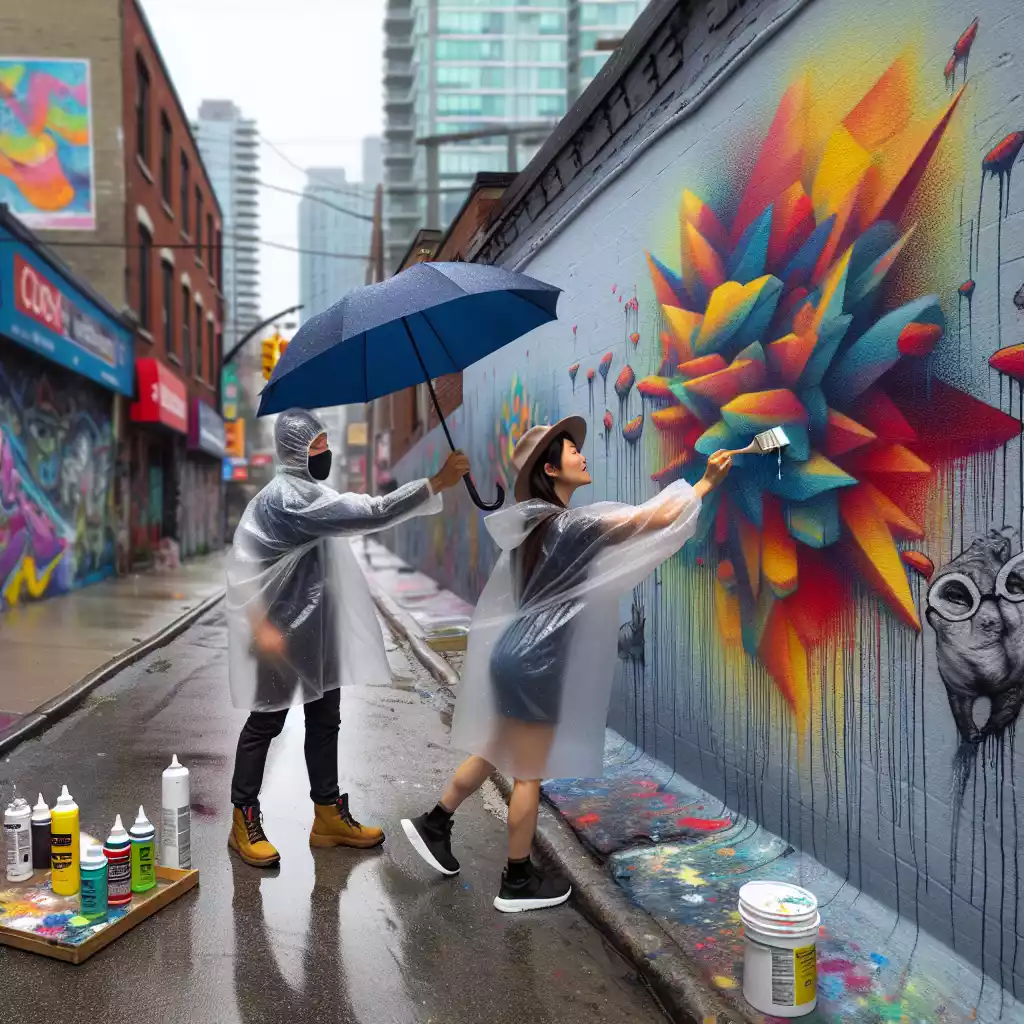Street art has always fascinated me. I remember my first encounter with a massive mural on a rainy day in Berlin. The colors seemed to shimmer under the raindrops, but I couldn’t help but wonder how the artist managed to keep such vivid art intact against the harsh weather. Street art is an expression that brings life to urban landscapes, but weather poses significant challenges. Let’s dive into how street artists can address these weather-related hurdles to ensure their masterpieces stand the test of time.
The Intersection of Street Art and Weather
Street art, an integral part of urban culture, often faces the wrath of Mother Nature. From rain-soaked walls to sun-faded colors, the elements can quickly degrade a piece of art. However, with the right knowledge and techniques, artists can protect their work from these environmental challenges.
Understanding Weather-Related Challenges
Common Weather Challenges for Street Artists
Rain and Moisture: Rain can wash away paint and cause mold growth. Moisture can seep into the walls, leading to peeling and cracking.
Sun Exposure and UV Rays: Prolonged sun exposure fades colors and causes paint to crack. UV rays can break down the chemical structure of the paint.
Wind and Debris: Strong winds can carry debris that scratches the surface of the artwork. Dust and dirt accumulation can dull the colors.
Temperature Fluctuations: Extreme temperature changes can cause paint to expand and contract, leading to cracks and chips.
Preparing for Weather Conditions

Selecting the Right Materials
Choosing the right materials is crucial for weatherproofing street art. Here are some options:
– Weather-Resistant Paints and Coatings: Opt for acrylic paints known for their durability. Use UV-resistant spray paints to prevent color fading.
– Durable Canvas and Surfaces: Consider using treated wood or metal surfaces that withstand harsh weather better than untreated materials.
Planning Your Artwork
Strategic planning can significantly reduce weather-related damage.
– Choosing Optimal Locations: Look for sheltered spots, such as under bridges or overhangs, to protect your art from direct exposure to the elements.
– Seasonal Timing for Street Art Projects: Plan your projects during seasons with mild weather to ensure paint dries properly and reduces the risk of immediate weather damage.
Techniques to Combat Weather Effects
Protective Coatings and Sealants
Applying protective coatings can shield your artwork from the elements.
– Types of Sealants: Use clear acrylic sealants for a protective layer. Polyurethane sealants offer robust protection but can alter the appearance slightly.
– Application Techniques: Apply sealant in thin, even layers. Allow each layer to dry completely before adding another.
Using Weather-Resistant Paints
Selecting the right type of paint can make a significant difference.
– Acrylic vs. Spray Paint: Acrylic paints are versatile and durable. Spray paints, especially those with UV protection, are excellent for quick projects.
– Benefits of UV-Resistant Paints: These paints resist fading and maintain vibrancy longer than standard paints.
Innovative Installation Methods
Thinking outside the box can help protect your art.
– Modular Art Pieces: Create art on removable panels that can be replaced or repaired individually.
– Temporary vs. Permanent Installations: Consider temporary installations for high-risk areas. These can be easily moved or replaced.
Maintenance and Preservation

Regular Maintenance Practices
Regular upkeep is essential for the longevity of street art.
– Cleaning and Upkeep: Gently clean the surface with a soft brush to remove dirt and debris. Avoid harsh chemicals that can damage the paint.
– Reapplying Protective Coatings: Periodically reapply sealants to maintain protection. Check for any signs of wear and address them promptly.
Repairing Weather Damage
Even with the best precautions, damage can occur.
– Touch-Up Techniques: Keep a supply of matching paint for touch-ups. Use fine brushes for detailed repairs.
– Professional Restoration Services: For significant damage, consider hiring professionals who specialize in art restoration.
Case Studies and Examples
Successful Street Art in Harsh Climates
Murals in Tropical Regions: Tropical climates pose challenges like heavy rain and high humidity. Artists often use waterproof paints and sealants to protect their work.
Art in Cold and Snowy Environments: Cold climates require paints that can withstand freezing temperatures. Artists in these regions often use thicker, more durable paints and apply multiple layers of sealant.
Lessons from Renowned Street Artists
Techniques from Experts: Renowned street artists often share their methods for combating weather challenges. For instance, some use specialized paints designed for marine environments.
Notable Projects and Their Challenges: Examining famous projects, such as Banksy’s murals, can provide valuable insights into effective weatherproofing techniques.
Community and Legal Considerations
Engaging the Local Community
Community involvement can play a crucial role in preserving street art.
– Community Involvement in Preservation: Local communities can help maintain and protect street art by reporting damage and participating in restoration efforts.
– Educational Workshops: Conduct workshops to educate the public about the importance of preserving street art and the techniques involved.
Navigating Legal and Permit Issues
Legal considerations are essential for any street art project.
– Obtaining Necessary Permits: Ensure you have the required permits before starting a project. This can prevent legal issues and potential removal of the artwork.
– Legal Protections for Street Art: Understand the legal protections available for street art in your area. Some regions have laws that protect street art as cultural heritage.
Future Trends and Innovations
Technological Advances in Street Art
Technology is revolutionizing street art, offering new ways to combat weather challenges.
– Smart Materials: New materials that respond to environmental changes can help preserve street art. For example, self-healing paints can repair minor damage automatically.
– Weather Forecasting Tools for Artists: Use weather apps and tools to plan your projects around favorable weather conditions.
Sustainable Practices in Street Art
Sustainability is becoming increasingly important in street art.
– Eco-Friendly Materials: Opt for eco-friendly paints and materials that have a lower environmental impact.
– Sustainable Project Planning: Plan projects with sustainability in mind, such as using recycled materials and minimizing waste.
FAQs
1. How can I protect my street art from rain?
Applying a clear acrylic sealant can protect your art from rain. Choose weather-resistant paints and select sheltered locations for your artwork.
2. What type of paint is best for outdoor murals?
Acrylic paints are highly recommended for outdoor murals due to their durability and weather resistance. UV-resistant spray paints are also a good option.
3. How often should I reapply protective coatings?
Reapply protective coatings every six months to a year, depending on the exposure to weather elements. Regular maintenance checks can help determine the need for reapplication.
4. Can I repair damaged street art myself?
Yes, minor repairs can be done using matching paints and fine brushes. For significant damage, consider hiring a professional restoration service.
5. Are there legal protections for street art?
Yes, many regions have laws protecting street art as cultural heritage. Always check local regulations and obtain necessary permits before starting a project.
Conclusion
Embracing the elements is part of the journey for street artists. By understanding and addressing weather-related challenges, artists can ensure their work remains vibrant and impactful. Whether you’re a seasoned artist or a beginner, these tips and techniques will help you create and preserve stunning street art that stands the test of time.
Hur Compliments Biden’s Memory | Mar-a-Lago Documents …
Ruth Aquilani is a renowned graffiti artist known for her bold, colorful, and expressive style. She began her career as a street artist in the early 2000s, quickly making a name for herself in the graffiti community with her unique and striking works of art.
